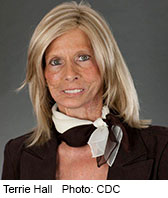
THURSDAY, Nov. 8 (HealthDay News) — A frank and graphic nationwide media campaign to motivate smokers to quit seems to be working, say researchers at the U.S. Centers for Disease Control and Prevention.
The public health initiative, known as Tips From Former Smokers, was launched by the CDC in March and ran until mid-June. A dozen or so ex-smokers offered very personal and often harrowing testimonials on the devastating health consequences that can result from years of tobacco use. Participants were featured in multiple 30-second televised public service announcements, radio commercials and web and print ads.
Now, a post-campaign assessment of its impact on a target audience of 18- to 54-year-old smokers suggests that the effort did indeed boost awareness — and perhaps even changed behavior.
No one is more pleased by, or proud of, such evidence of the campaign’s success than participant and former smoker Terrie Hall.
“When they asked me to be a part of this campaign I had no idea of the impact that they would have,” Hall said. “I had no idea of the overwhelming and unbelievable experience that I would have with it. I feel like the CDC really did an outstanding job of telling people what it’s like if you smoke, and what can happen if you smoke.”
For this Lexington, N.C., resident, what happened was cancer.
“I’ve had it 10 times now,” Hall said, her voice stressed and labored as a permanent consequence of throat cancer and the laryngectomy surgery she had many years ago. The surgery resulted in the removal of her voice box (larynx), meaning that today she must breath through an opening in her neck and speak with mechanical assistance.
“Everything that’s happened to me has come from the fact that I smoked cigarettes,” Hall said. “That means that every day I have to put in my teeth, I have to put in a talking device in my neck, I have to wear a wig. That’s how I get ready for my day. I’ve had a lot of radiation, and I’m still going to chemotherapy. It’s all taken quite a toll on me.”
Putting a face to smoking-related disability — in a way that people can relate to — was the campaign’s goal.
“What we decided to do was essentially try to give the American people more of a real feeling of what’s behind the statistics,” said Dr. Tim McAfee, director of the CDC’s Office on Smoking and Health.
The campaign did just that by “giving a voice and a strong sense of humanity to people who have been the victims,” McAfee said. “Not helpless, pathetic victims, but people who want their stories told about what’s been happening over the last 50 years, and who don’t want to see this happen to anybody else.”
During the campaign, the CDC saw a huge uptick in the percentage of American smokers who called in to their 1-800-QUIT-NOW information line.
Nearly 158,00 calls came in during the equivalent time frame in 2011. During the 2012 campaign, however, that number skyrocketed to more than 365,000, amounting to a 132 percent jump in calls.
The national online portal (www.smokefree.gov) saw an even bigger relative rise in traffic. Roughly 630,000 people visited the site at some point during the campaign, compared with fewer than 120,000 visitors during the same period in 2011 — a whopping 428 percent increase.
Hall and the campaign also reached out to 10,000 students to provide a cautionary tale of what can happen when you light up.
Peer pressure, Hall said, caused her to pick up her first cigarette at age 17. And addiction turned her into a two-packs-a-day smoker, a habit she hung on to for 23 years.
“When I was a teenager there was no tobacco education,” Hall said. “I wish I had had someone like me come visit my school and show me how tobacco would affect my body. Maybe I would have made a more educated decision about what I would do with cigarettes.”
Danny McGoldrick, the Washington, D.C.-based vice president for research at the Campaign for Tobacco-Free Kids, praised the CDC effort.
“We’ve been advocates of this kind of media campaign for years,” McGoldrick said. “We know this works.”
He added, however, that “it’s not enough to run a campaign like this just 12 weeks a year, when the tobacco companies spend 52 weeks a year making their case to keep smokers smoking.”
McAfee, from the CDC, said the agency is planning a second campaign in 2013 highlighting seven or eight former smokers.
More information
For more on the Tips From Former Smokers campaign, visit the U.S. Centers for Disease Control and Prevention.

